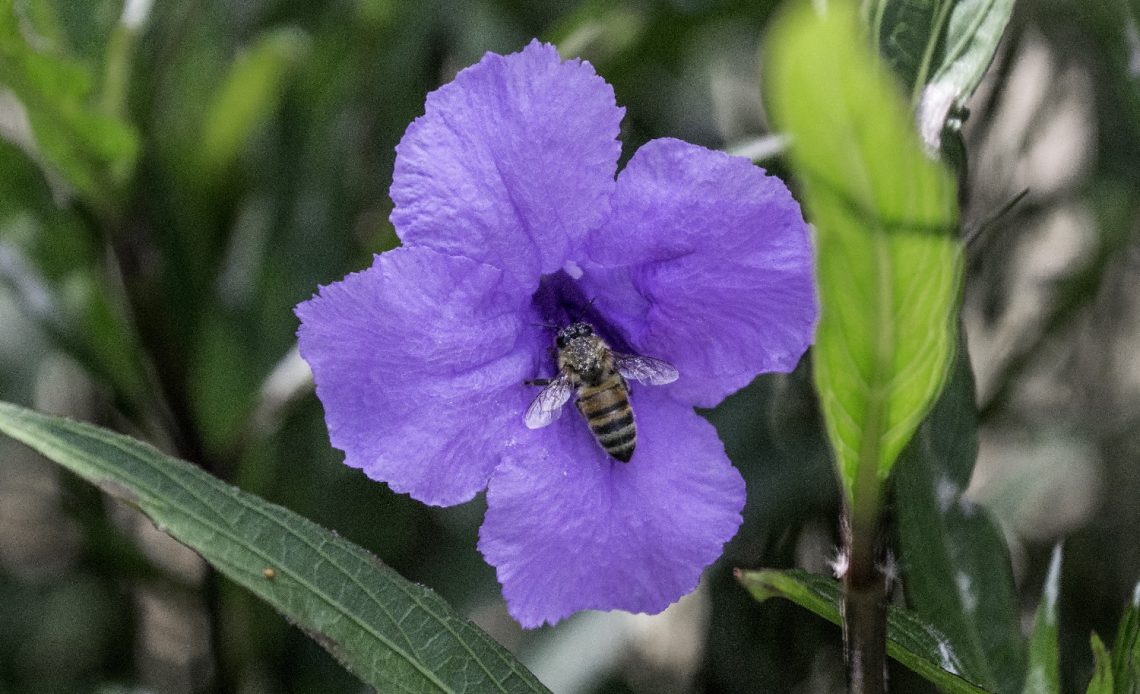

We’re here to help! Wild Yards is a completely free website that is 100% dedicated to helping you create a wildlife-friendly, sustainable yard. Read more
WildYards is reader-supported. When you buy a product through a link on our site, we may earn a comission. Every product is independently selected by our (obsessive) editors and our reviews are unbiased and objective. Read more about our mission or our privacy policy.
With their tubular-shaped heads and stunning colors, it’s no wonder that petunias are so popular. They make for perfect hanging basket flowers and look great across the garden – but can you rely on them to keep pollinators coming back? Do bees like petunias, for example?
Bees do like petunias, but they don’t tend to favor them. You will only ever really see a bee around a petunia if there’s little other nectar on offer, or if they happen to be in the mix with other, more interesting flowers.
Why don’t bees love petunias?
While they are bright and fragrant, petunias contain very little nectar for their needs, so while they might look the part, they simply don’t deliver on their promise of food for the average roving bee.
You may occasionally see bees flitting around petunias, but that is usually only the case when they have been planted next to other attractive flowers – such as lavender, tulips, and sunflowers. Alternatively, it may be that your garden, or the wider area, is considerably sparse on nectar.
You can, hypothetically, attract bees with petunias – but it’s never a recommended option for regular visits. Bees like open flowers with bright colors (providing they’re not red or orange – as they have difficulty seeing these tones). Keep in mind that petunia will generally disappoint most bees once investigating, which means if you have little else to offer in your garden, they will hunt for nectar elsewhere.
Consider swapping your petunias out for something a little more bee-friendly. For example, pansies tend to bring in more satisfied customers in an equally vibrant array of colors.
What other pollinators do petunias attract?
Even though petunias aren’t the best at attracting bees, they’re great at attracting other pollinators such as hummingbirds and butterflies. Butterflies, in particular, aren’t terribly picky unless they have accessibility problems.
Their slightly tubular shapes make them ideal for hummingbirds to extract the nectar from their centers. Their wide petals make for the perfect landing spots for butterflies as they chow down on the nectar within.
Petunias are full-sun loving, annual flowers, making them particularly easy for these pollinators to spot in wide-open gardens. Butterflies, in particular, won’t head into the shade much to feed.
It’s worth growing petunias to attract pollinators if you specifically want to avoid bees. For example, you may be allergic to their stings or simply prefer watching hummers and flutterers instead!
If you want to attract bees, butterflies, and hummingbirds to your yard, try growing petunias among various specimens. This will help provide your birds and butterflies with ‘exclusive’ feeding spots while bees prefer more reliable nectar sources.
What plants should you keep near petunias to attract bees?
Consider colors first – bees are particularly attracted to shades of white, yellow, blue, and purple. They won’t head for reds, pinks, and oranges.
Choose blooms that are open and single-flowered – bees, like most pollinators, appreciate an obvious snack, meaning simplicity in ‘design’ is a must.
You’ll likely attract bees with honeysuckle, clematis, and star jasmine for further inspiration. They also love sweet-smelling herbs such as rosemary and mint.
Growing a garden replete with herbs and flowers is the best course of action for welcoming the widest variety of pollinators.
How to grow petunias to attract pollinators
If you’re set on growing petunias to welcome pollinators, you will need to wait until the spring or the early summer to plant them outside. As long as you are sure that the last frost of the winter has passed, then you can proceed.
Petunias need nourishing soil in order to thrive, so preparing the ground with some good compost before planting them is ideal. If you’re planning on growing them in a pot, then planting them in peat-free compost is also advisable.
In pots, petunias can be kept pretty close together, but they should be anywhere from 15 cm to 40 cm apart in the ground.
Petunias need plenty of sunlight, with just partial shade during the day. If they are in pots, it will be easy to move them around accordingly, but if they are in the ground, ensure that they are in a sunny spot with just a bit of shade.
Unlike many other flowers, you must ensure that your petunias’ soil never dries out completely. Moisten the soil around the plant, primarily to avoid the sun burning the flowers during the peak heat of the season. They will likely need watering every day.
Will bees avoid petunias?
Bees won’t avoid petunias outright, but growing these flowers alone to attract local buzzers is a poor strategy. As they are great for welcoming other types of creatures into your garden, mix them with a blend of flowers bees love – and they may dip into your petunias occasionally.
